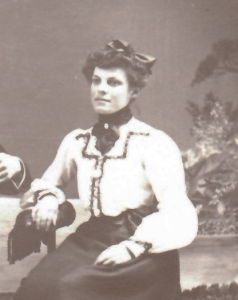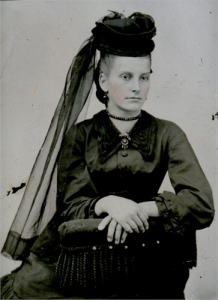Above, left: Eugénie Vallée. Above, right: Marie Trottier.
This blog post, a sequel to “The widow of St. Casimir,” contrasts the lives of two women, Eugénie Vallée (1880–1973) and Marie Trottier (1855–1928), first cousins born in St. Casimir, Québec a generation apart. (Eugénie's mother, Lumina de Varennes [1844–1922], was the younger sister of Marie's mother, Léocadie de Varennes [1828–1897].) Marie came to my attention through an online family tree with an elegant photo of her circa 1875. Eugénie’s grandchildren were immediately struck by the strong resemblance between their grandmother at the same age and Marie. Did these look-alike cousins, who likely never met, have similar experiences in their migration path to the Unites States, where they lived the majority of their lives?
In 1896, following the fatal industrial accident of Hermidas Vallée, Eugénie’s father, the mill owner Michel-Adolphe Grandbois paid for sixteen-year-old Eugénie’s tuition at Laval College to earn a teaching certificate as a means of supporting her widowed mother. In the 1901 St. Casimir Québec census, Eugénie is listed as an institutrice [teacher], but she found that she earned more money as a tailor. Her destiny, like that of Marie Trottier, would take her across the border.
Eugénie’s elder half-sister Claudia had already moved to Winooski, Vermont, where she worked in the woolen mills. Claudia soon married Gustave Lavallée, a blacksmith, born in the neighboring Québec town of Cap Santé. Claudia died giving birth to a third stillborn child. Gustave parceled out their surviving two sons to relatives. Gustave evidently made return trips to St. Casimir.
Eugénie’s children ... supported their mother for the rest of her long widowhood.
At 25, Eugénie, likely at her mother’s behest, married her brother-in-law Gustave in the parish church, and the couple immediately moved to Vermont. Eugénie bore seven children over the next fourteen years. Gustave struggled to earn a living as horses gave way to cars. He died of cancer, age 56. Eugénie’s children, all of whom left school in their youth to work, supported their mother for the rest of her long widowhood. Eugénie never learned English. Her world revolved around her family and St. Francis-Xavier Catholic Church, which kept its French Mass through the Vatican II era.
According to the 1900 Woonsocket, Rhode Island, census, Marie Trottier claimed to have been in the United States since 1866, but her family’s migration was more complicated than Eugénie’s one train-ride move. Marie’s parents, Joseph Trottier and Léocadie de Varennes, lived in several places in Québec, as reflected in the baptismal records of their children. They lived in Rhode Island during the Civil War, but Léocadie, widowed by 1874, returned to St. Casimir. She moved next to Moorehead, Minnesota, where she appeared in the 1880 census – then back to St. Casimir by the 1881 census.
Her children scattered in pursuit of jobs. Léocadie’s nineteen-year old daughter Marie Trottier lived in Woonsocket when she married Jean Baptiste “John” Lagacé on 22 November 1875 at Precious Blood Church, a Catholic parish established for Québec immigrants. They remained in Woonsocket. Marie bore fourteen children, of whom eight died in infancy or childhood. Marie’s husband John, a mason, eventually prospered and bought a home on Rathbun Street. They lived long enough to celebrate their fiftieth wedding anniversary.
They lived long enough to celebrate their fiftieth wedding anniversary.
Marie and Eugénie, chronologically more akin to mother and daughter because of the difference in their ages and when they emigrated, nonetheless had some experiences in common. Though husbands became American citizens, the St. Casimir cousins lived in French-speaking enclaves which resisted the pressure of assimilation. Staunch Catholics, they expected their children to marry “within their own kind,” and all of them did. They would have shared the belief that adherence to their native language was essential to maintaining their faith. Living sixty years in the United States would not have changed their perception of church and family. As fitting testament to these women remembering their birthplace and heritage, their cemetery stones, within their beloved French parish cemeteries, inscribe their life dates and the word épouse [wife].
Share this:

About Michael Dwyer
Michael F. Dwyer first joined NEHGS on a student membership. A Fellow of the American Society of Genealogists, he writes a bimonthly column on Lost Names in Vermont—French Canadian names that have been changed. His articles have been published in the Register, American Ancestors, The American Genealogist, The Maine Genealogist, and Rhode Island Roots, among others. The Vermont Department of Education's 2004 Teacher of the Year, Michael retired in June 2018 after 35 years of teaching subjects he loves—English and history.View all posts by Michael Dwyer →

